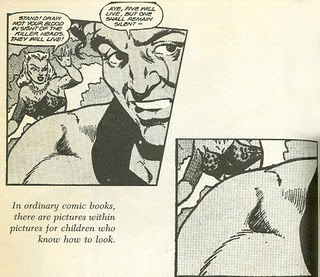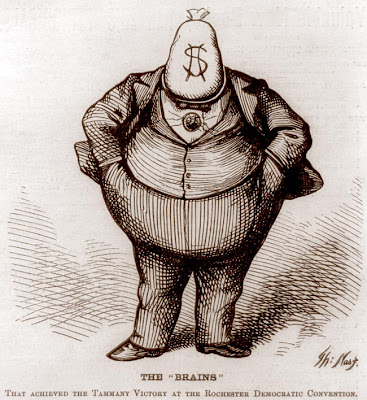WORDS THAT SHOULDN'T BE ILLUSTRATED
Illustrations can enhance words, but not everyone is interested in having their words enhanced. In fact, translating words into pictures sometimes provokes people to violence. This reaction is a tribute to the power of illustration (although many illustrators, given a choice, might prefer the second prize).
Some reasons for hostile reactions to pictures are obvious. Thomas Nast's political cartoons were more effective than written articles in ending the corrupt regime of William "Boss" Tweed of New York. Tweed is reported to have cursed, "Stop them damn pictures! I don't care what the papers write about me. My constituents can't read, but they can see the pictures."
Later when Tweed was convicted of fraud, he fled to Spain where the authorities reportedly used one of Nast's cartoons to identify and capture him.
Another reason for objecting to illustrations is that they can seem more vividly offensive than the words they illustrate. Norman Lindsay's illustrations for the classic play Lysistrata were censored although Aristophanes' words were not.
Similarly, the authorities censored Aubrey Beardsley's illustrations of Oscar Wilde's play, Salome. Such pictures can cross the line even when their accompanying text does not.
Readers are free to imagine anything words describe, as long as the images remain in their heads. Once an artist puts those images in tangible form, he confirms his enemies' worst suspicisions about what goes on in his lurid mind, and provides them with evidence to use against him at trial.
Some argue that pictures are more dangerous than words because they are more accessible to young, impressionable audiences. The slightly demented Frederic Wertham urged censorship of comic books in the 1950s out of concern that pictures containing plural meanings might corrupt America's youth.
But perhaps the most interesting argument against illustration is that certain subjects are too important to be pictured at all. That's the topic I'd like to chat about this week. According to this view, any visual form created by human imagination can only limit or debase certain subjects, no matter how talented the artist, no matter how moral, respectful or chaste the image. We get this argument most often from theological circles, where true believers argue that drawing or painting a divine subject necessarily limits something that by definition is unlimited.
The Prophet Muhammad is repeatedly quoted as saying that artists should burn in hell for painting pictures:
While this position appears contrary to mainstream Islamic thought about pictures, the resulting threats against Norris' life were sadly real. Her employer reported that on the advice of the FBI, Norris was "moving, changing her name, and essentially wiping away her identity."
The notion that drawing an object can be a sacriligious act is not confined to Islam. This is an age old battle, spanning many religions, between cataphatic and apophatic theology. The Ten Commandments (Exodus 20:3) contain a pretty broad prohibition against creating likenesses:
The Commandment against making a likeness carried through to early Christianity; it's difficult to find Christian images prior to the third century, at which point many Christians seem to have accepted that illustrations of holy subjects could be an important tool in promoting the young religion. Centuries later, there were still traditionalists who feared that images could violate the second Commandment, resulting in idol worship. Others became alarmed because visual depictions sometimes exposed apparent inconsistencies in church dogma. There were repeated periods when religious leaders, believing that "misinterpretation of religious images often leads to heresy, banned all pictorial representations and began a systematic destruction of holy images."
It is easy to understand Boss Tweed's resentment toward political cartoons, but are there any thoughtful observations to be made about this more impassioned view that certain subjects are just too important to be pictured?
For me, the Book of Job is one of the most profound poems about the human condition. It speaks to both the religious fundamentalist and the dedicated atheist. Job searches for meaning from the whirlwind, looking for answers in a form that could make sense to his poor human brain. The whirlwind responds that there are no answers for Job, and that he'd better get accustomed to disappointment. Job learns that God has no intention of explaining himself to humans until we are able to create a bird or a fish, as God does. Discussing efforts by Job and his friends to understand the universe, Princeton's Michael Sugrue states, "the book of Job suggests that in a way, all theology is blasphemy because it seeks to make God comprehensible to the mind of man.... The answer to why God sent evil into the world is: don't ask."
 |
| God separating light from darkness in the book of Genesis (Michelangelo) |
Illustrations can enhance words, but not everyone is interested in having their words enhanced. In fact, translating words into pictures sometimes provokes people to violence. This reaction is a tribute to the power of illustration (although many illustrators, given a choice, might prefer the second prize).
Some reasons for hostile reactions to pictures are obvious. Thomas Nast's political cartoons were more effective than written articles in ending the corrupt regime of William "Boss" Tweed of New York. Tweed is reported to have cursed, "Stop them damn pictures! I don't care what the papers write about me. My constituents can't read, but they can see the pictures."
Later when Tweed was convicted of fraud, he fled to Spain where the authorities reportedly used one of Nast's cartoons to identify and capture him.
Another reason for objecting to illustrations is that they can seem more vividly offensive than the words they illustrate. Norman Lindsay's illustrations for the classic play Lysistrata were censored although Aristophanes' words were not.
Similarly, the authorities censored Aubrey Beardsley's illustrations of Oscar Wilde's play, Salome. Such pictures can cross the line even when their accompanying text does not.
Readers are free to imagine anything words describe, as long as the images remain in their heads. Once an artist puts those images in tangible form, he confirms his enemies' worst suspicisions about what goes on in his lurid mind, and provides them with evidence to use against him at trial.
Some argue that pictures are more dangerous than words because they are more accessible to young, impressionable audiences. The slightly demented Frederic Wertham urged censorship of comic books in the 1950s out of concern that pictures containing plural meanings might corrupt America's youth.
 |
| When I first read Wertham's book as a boy, I couldn't figure out what I was supposed to be seeing here. Now that I understand, he seems even crazier than he did back then. |
But perhaps the most interesting argument against illustration is that certain subjects are too important to be pictured at all. That's the topic I'd like to chat about this week. According to this view, any visual form created by human imagination can only limit or debase certain subjects, no matter how talented the artist, no matter how moral, respectful or chaste the image. We get this argument most often from theological circles, where true believers argue that drawing or painting a divine subject necessarily limits something that by definition is unlimited.
The Prophet Muhammad is repeatedly quoted as saying that artists should burn in hell for painting pictures:
Last year, gentle Seattle cartoonist Molly Norris, dismayed by growing censorship of drawings of the Prophet Muhammad, suggested a "Draw Mohammed Day." She did not urge that the drawings be disrespectful or unflattering, only that artists exercise their right to draw anything, including Muhammad, lest artists wake up one day and discover that their rights had disappeared altogether. Her impertinence earned Norris a death sentence from the thoroughly demented cleric Anwar al-Awlaki who instructed his followers, "her proper abode is Hellfire."Verily the most grievously tormented people amongst the denizens of Hell on the Day of Resurrection would be the painters of pictures...." (Sahih Muslim vol.3, no.5271)
The painter of these pictures will be punished on the Day of Resurrection....'" (Bukhari vol.9, book 93 no.646)
 |
| Pakistanis burning cartoonist Norris in effigy |
While this position appears contrary to mainstream Islamic thought about pictures, the resulting threats against Norris' life were sadly real. Her employer reported that on the advice of the FBI, Norris was "moving, changing her name, and essentially wiping away her identity."
The notion that drawing an object can be a sacriligious act is not confined to Islam. This is an age old battle, spanning many religions, between cataphatic and apophatic theology. The Ten Commandments (Exodus 20:3) contain a pretty broad prohibition against creating likenesses:
Thou shalt not make unto thee a graven image, nor any manner of likeness, of any thing that is in heaven above, or that is in the earth beneath, or that is in the water under the earth.Different versions of this prohibition recur throughout the Old Testament, where we learn that a wrathful God may go so far as to punish an artist's great grandchildren.
 |
| God creating the earth in the book of Genesis (Michelangelo) |
It is easy to understand Boss Tweed's resentment toward political cartoons, but are there any thoughtful observations to be made about this more impassioned view that certain subjects are just too important to be pictured?
For me, the Book of Job is one of the most profound poems about the human condition. It speaks to both the religious fundamentalist and the dedicated atheist. Job searches for meaning from the whirlwind, looking for answers in a form that could make sense to his poor human brain. The whirlwind responds that there are no answers for Job, and that he'd better get accustomed to disappointment. Job learns that God has no intention of explaining himself to humans until we are able to create a bird or a fish, as God does. Discussing efforts by Job and his friends to understand the universe, Princeton's Michael Sugrue states, "the book of Job suggests that in a way, all theology is blasphemy because it seeks to make God comprehensible to the mind of man.... The answer to why God sent evil into the world is: don't ask."
I suspect opponents of sacred illustration are telling us, "don't ask" how divine things look. Don't try to define God as having a long white beard and a white bath robe with a gold "G" on the pocket. Divine subjects are inscrutable and need to be defended against callow and presumptuous artists who believe they can define the undefinable with glib visualizations.
But this seems a pretty shallow reaction to a pretty profound subject. By focusing on physical likenesses, they address the religious experience at its most superficial level. Artists such as Frazetta or R. Crumb have done powerful, inspirational-- some might even say divine-- work, but it certainly won't be found among their representational pictures of deities, which are so lame it is comical to think they could alter anyone's thinking.
But this seems a pretty shallow reaction to a pretty profound subject. By focusing on physical likenesses, they address the religious experience at its most superficial level. Artists such as Frazetta or R. Crumb have done powerful, inspirational-- some might even say divine-- work, but it certainly won't be found among their representational pictures of deities, which are so lame it is comical to think they could alter anyone's thinking.
 |
| Frazetta's "King of Kings" |
 |
| R. Crumb's God of the Old Testament |
There may be much that is sacred in art. (For example, some people claim that meditating on a large Rothko painting puts them in touch with sacred feelings.) And some art may be legitimately unsettling to some religions views. But those who claim to protect the sacred from physical likenesses may be more concerned with protecting the bureaucracy and infrastructure of religious institutions (and perhaps the prerogatives of clergy) than preserving the experience of the divine.




